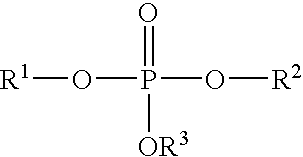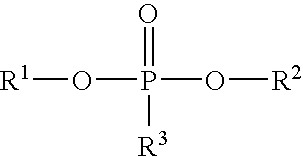Resin composition and an article formed therefrom
a technology of composition and composition, applied in the field of resin composition and an article formed therefrom, can solve the problems of poor adhesion when compared to pur foam, general non-useful for large-scale molding operations, and foam gels tend to gel too quickly, so as to improve the flexibility of formulation and manufacturing requirements, improve the adhesion strength, and reduce the effect of manufacturing requirements
- Summary
- Abstract
- Description
- Claims
- Application Information
AI Technical Summary
Benefits of technology
Problems solved by technology
Method used
Image
Examples
examples
[0052]The article of the present invention is made by combining a halogenated polyol, a brominated polyol, a flame retardant, and a supplemental polyol different from the brominated and halogenated polyols, a catalyst, a blowing agent, a surfactant, and optionally, an adhesion promoter in a vessel to form a resin composition. The resin composition and an isocyanate are then mixed together in a reaction vessel such as by spraying and react to form an article. The article is observed for cream time, gel time, tack-free time, and other properties. The amount and type of each component used to form the article is indicated in Table 1 below with all values in percent by weight based on the total weight of the resin composition unless otherwise indicated.
TABLE 1ComponentArticle 1Article 2Article 3Article 4Resin CompositionPolyol A37.0438.8842.0042.50Polyol B9.9210.420.009.92Flame Retardant10.9111.4610.910.00Polyol C15.2115.9720.1720.66Polyol D3.974.173.973.97Catalyst A0.400.420.400.40Cata...
PUM
| Property | Measurement | Unit |
|---|---|---|
| density | aaaaa | aaaaa |
| gel time | aaaaa | aaaaa |
| temperatures | aaaaa | aaaaa |
Abstract
Description
Claims
Application Information
 Login to View More
Login to View More - R&D
- Intellectual Property
- Life Sciences
- Materials
- Tech Scout
- Unparalleled Data Quality
- Higher Quality Content
- 60% Fewer Hallucinations
Browse by: Latest US Patents, China's latest patents, Technical Efficacy Thesaurus, Application Domain, Technology Topic, Popular Technical Reports.
© 2025 PatSnap. All rights reserved.Legal|Privacy policy|Modern Slavery Act Transparency Statement|Sitemap|About US| Contact US: help@patsnap.com



